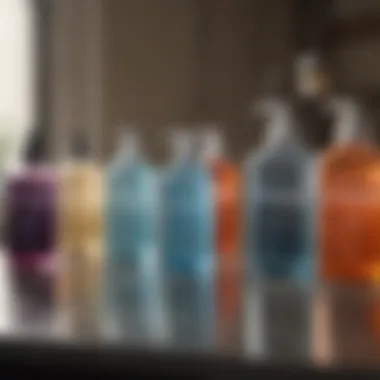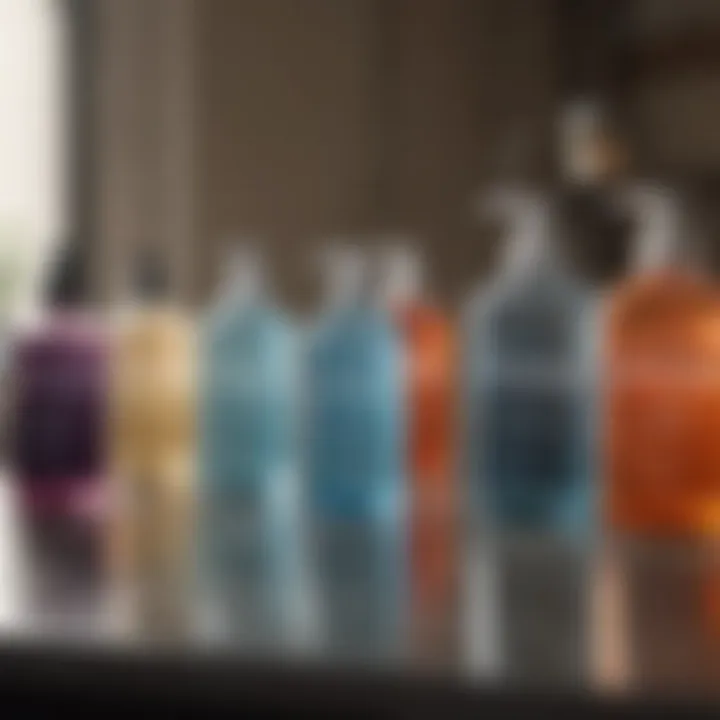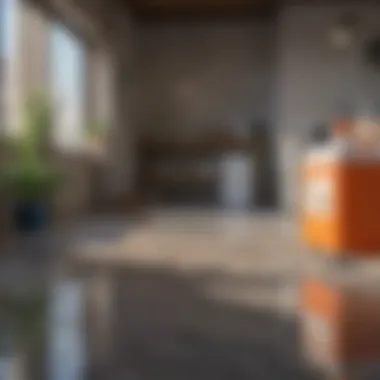Sanitizers vs. Disinfectants: Key Differences Explained


Intro
In the quest for cleanliness and hygiene, understanding the distinction between sanitizers and disinfectants is fundamental. Though both serve to eliminate harmful pathogens, their processes and applications differ significantly. Recognizing these differences enables individuals to make informed choices about which products to use in various settings, from homes to businesses.
Importance of Cleanliness in Public Health
The recent global events have heightened the awareness of hygiene. Effective cleaning practices play a crucial role in controlling the spread of infectious diseases. Thus, the knowledgeable application of sanitizers and disinfectants has become critical in our daily routines.
Key Definitions
Sanitizers
Sanitizers reduce the number of germs on surfaces to a safe level as designated by public health standards. They are effective against bacteria but less so against viruses and fungi.
Disinfectants
Disinfectants, on the other hand, are stronger chemicals. They kill a broader range of pathogens, including viruses, fungi, and bacteria. They are usually used on hard surfaces where complete elimination of germs is necessary.
Chemical Composition and Effectiveness
To comprehend the capabilities of these products, let us explore their chemical make-up. Sanitizers typically contain alcohol or quaternary ammonium compounds. Disinfectants may contain bleach or hydrogen peroxide, designed to achieve a higher level of germ elimination.
Effectiveness of Each
- Sanitizers: More suitable for hand hygiene and low-risk environments.
- Disinfectants: Required in high-risk settings, such as hospitals and laboratories.
Appropriate Usage Scenarios
Knowing when to use sanitizers versus disinfectants is crucial for achieving effective cleanliness. Areas such as kitchens and bathrooms often benefit from disinfectants due to higher germ exposure.
Common Examples
- Sanitizers: Hand sanitizers are ideal for quick disinfection when soap and water are unavailable.
- Disinfectants: Surface sprays and wipes are used post-cleaning to eliminate any remaining germs.
End
In summary, both sanitizers and disinfectants have vital roles in maintaining hygiene. Understanding their differences, uses, and effectiveness will empower individuals to select the best products for their specific needs. This knowledge is essential, especially as cleanliness becomes increasingly critical in public health discussions.
Prolusion to Cleaning Agents
Cleaning agents play a crucial role in maintaining hygiene in various environments. They are essential in both households and public spaces, especially in light of increased awareness of health and safety standards. Understanding the differences between sanitizers and disinfectants is vital for informed decision-making regarding cleanliness. This section sets the foundation for the entire discourse, offering insights into the significance of cleaning agents in everyday life and their implications on public health.
Understanding the Basics
Cleaning agents can be broadly classified into two major categories: sanitizers and disinfectants. While both serve to reduce the presence of microorganisms, their efficacy and applications vary greatly. Sanitizers primarily reduce bacteria to safe levels, suitable for surfaces that come into contact with food or skin. Conversely, disinfectants aim to eliminate a broader spectrum of pathogens, including viruses and fungi, making them appropriate for healthcare settings and high-touch surfaces.
The comprehension of these distinctions is essential for effective cleaning and infection control. Users should select cleaning agents based on the specific needs of their environment. For instance, kitchens and dining areas benefit from sanitizers, whereas hospitals require disinfectants to prevent healthcare-associated infections.
Role in Public Health
The impact of sanitizers and disinfectants extends beyond personal hygiene; they are integral to public health. Effective cleaning practices help prevent the spread of diseases, particularly in densely populated areas. For example, during health crises, such as pandemics, the proper use of these agents becomes paramount.
Moreover, public facilities—from schools to transportation systems—must adhere to strict cleaning protocols. This is not only to protect individual health but also to contribute to wider community well-being.
"Effective use of cleaning agents is essential in reducing transmission rates of infectious diseases, thereby enhancing public health outcomes."


In summary, understanding cleaning agents, specifically sanitizers and disinfectants, helps in navigating the complexities of hygiene management. By grasping their definitions and public health roles, individuals and organizations can better implement sanitation strategies that promote health and safety.
Defining Sanitizers
Understanding the definition and implications of sanitizers is crucial for distinguishing them from disinfectants. This distinction aids in comprehending their roles in cleaning practices and public health. Sanitizers are generally applied to reduce germs on surfaces to a safe level, as determined by public health standards. Their use is especially prevalent in areas where food is prepared or served, as maintaining health standards in these environments is essential.
What is a Sanitizer?
A sanitizer is a type of cleaning agent that significantly reduces the number of microorganisms on surfaces to a safe level. According to the Centers for Disease Control and Prevention (CDC), sanitizers are effective against certain bacteria and viruses but may not eliminate all pathogens. The effectiveness of a sanitizer depends on its concentration and the amount of time it remains in contact with the surface. For many applications, a solution of at least 60% alcohol is considered effective for sanitizing.
Common Uses of Sanitizers
Sanitizers find broad application across various sectors. They are commonly used in:
- Food service: Sanitizing kitchen counters, utensils, and equipment.
- Healthcare: Cleaning surfaces in hospitals and clinics to prevent the spread of infections.
- Education: Wiping down desks and other shared surfaces in schools maintains hygiene and prevents illness.
- Everyday household: Using hand sanitizers to kill germs when soap and water are unavailable.
The versatility of sanitizers makes them a necessary tool for maintaining hygiene, especially in crowded or shared spaces.
Chemical Composition of Sanitizers
Sanitizers can contain different chemical components depending on their intended use. Common active ingredients include:
- Alcohol: Ethanol or isopropyl alcohol at concentrations ranging from 60% to 90%.
- Chlorine Compounds: Sodium hypochlorite which is often used in both household and industrial settings.
- Quaternary Ammonium Compounds (Quats): Effective against various types of germs but may have effectiveness challenges against certain viruses.
Understanding the chemical makeup helps in choosing the right sanitizer for effective cleaning. Each type has specific strengths and limitations, making it important to select the appropriate one for the intended application.
"Sanitizers reduce germs to a safe level, making them vital in settings where hygiene is critical."
When choosing sanitizers, consider the type of surface, the nature of potential contaminants, and applicable public health guidelines. This knowledge is imperative for effective cleaning and infection control.
Defining Disinfectants
Understanding disinfectants is essential when discussing cleaning agents. They play a critical role in enhancing public health. Disinfectants are often employed in environments that require stringent hygiene standards, such as hospitals, restaurants, and schools. This section will outline the specific characteristics that define a disinfectant, its common applications, and its chemical makeup.
What is a Disinfectant?
A disinfectant is a chemical agent used to eliminate or significantly reduce harmful microorganisms on surfaces. These agents do not necessarily need to remove dirt or organic matter; their primary focus is on microbial destruction. Disinfectants are registered with regulatory bodies, ensuring they meet specific efficacy standards. This registration process ensures a degree of safety and effectiveness, which is crucial in environments where preventing the spread of infections is vital.
Common Uses of Disinfectants
Disinfectants are widely used in various settings. Common applications include:
- Healthcare Settings: Hospitals utilize disinfectants on surgical tools and surfaces to prevent infections.
- Households: Many people use disinfectant sprays or wipes in kitchens and bathrooms to eliminate germs.
- Food Service Areas: Restaurants often use disinfectants to sanitize food preparation areas, ensuring food safety.
- Public Spaces: Disinfectants are essential in schools and public transport, where a high volume of foot traffic increases the risk of spreading germs.
The versatility of disinfectants makes them a cornerstone of hygiene practices in numerous areas.
Chemical Composition of Disinfectants
Disinfectants can vary widely in their chemical composition. Some common types include:
- Bleach (Sodium Hypochlorite): This is a traditional disinfectant known for its effectiveness against a broad spectrum of pathogens. Its strong oxidizing properties make it suitable for various surfaces.
- Quaternary Ammonium Compounds: Often referred to as quats, these disinfectants are popular for their ability to sanitize without harsh odors, making them suitable for homes and commercial settings alike.
- Alcohols (Ethanol and Isopropyl Alcohol): Effective against many bacteria and viruses, alcohol-based disinfectants are often used in hand sanitizers and surface wipes.
It is important to note that the effectiveness of a disinfectant can depend on its concentration and contact time with the surface being treated.
Comparative Analysis
The comparative analysis between sanitizers and disinfectants is at the core of understanding their respective roles in cleaning and hygiene practices. This section aims to dissect the fundamental differences between these cleaning agents. By having a clear understanding of their efficacy, duration of effectiveness, and impact on surfaces, readers can make educated decisions based on specific needs. Such analysis is particularly significant in the context of public health, where the choice of cleaning agents contributes to infection control measures. The outlined sections will assist in clarifying which agent is suitable for a given situation and which parameters to consider.


Efficacy Against Microorganisms
Both sanitizers and disinfectants target microorganisms but vary in effectiveness. Sanitizers typically reduce the number of bacteria on surfaces to safe levels, which can be sufficient in specific contexts such as food preparation areas. In contrast, disinfectants aim to kill most microorganisms outright. For instance, products like Lysol Disinfectant Spray are formulated to eliminate 99.9% of viruses and bacteria.
It's pivotal to understand the type of pathogens that a cleaning agent is effective against. Different agents have various active ingredients, which influence their overall efficacy. For example, alcohol-based sanitizers, such as Purell, work well against bacteria and some viruses but are less effective against spores. On the other hand, bleach-based disinfectants are powerful against a broader range of pathogens but necessitate a specific contact time to achieve maximum effectiveness. This means that selecting the right product is essential to ensure optimal outcomes when dealing with contamination.
Duration of Effectiveness
The duration of effectiveness varies significantly between sanitizers and disinfectants. Sanitizers, once applied, might not provide long-lasting protection and often require reapplication after a short period, especially on frequently touched surfaces. For instance, if you used a sanitizer on the kitchen counter, it might need reapplied after it gets dirty again.
In contrast, disinfectants can offer transient residual protection if left on surfaces for a significant time. However, this protection diminishes with environmental factors such as moisture or disturbances from regular use. Understanding these dynamics is essential when choosing between products to maintain a cleaner space.
Impact on Surfaces
Considering the impact on surfaces is crucial when selecting a cleaning agent. Sanitizers are generally safe for a variety of surfaces, including food contact areas, as they are designed not to leave harmful residues. Products like Seventh Generation Dish Liquid demonstrate this by being effective without harsh chemicals.
Disinfectants, while powerful, might not be suitable for all surfaces. For instance, using a strong bleach solution on wood can damage the finish over time. Manufacturers often provide guidelines indicating where their products can be safely used. It is vital to consider the material of the surface being cleaned to prevent potential damage. Always consult the label for guidance on appropriate applications.
Key Takeaway: Choosing the right cleaning agent involves understanding both the efficacy against specific pathogens and how the product impacts the surfaces being cleaned. Each agent has its unique strengths and weaknesses, making it important to assess the context of use.
Health and Safety Considerations
Understanding the health and safety considerations regarding sanitizers and disinfectants is essential in maintaining a safe environment. Both products serve vital functions in hygiene, but they also come with potential risks that users must navigate. Recognizing these risks ensures informed decisions that protect human health while effectively managing cleanliness. It incorporates regulatory guidelines and personal handling practices, promoting overall wellbeing in both residential and commercial settings.
Potential Risks of Sanitizers
Sanitizers are formulated to reduce the number of bacteria on surfaces. However, improper use can lead to some risks. For instance, many sanitizers contain alcohol and other chemicals that can be harmful if ingested or if they come in contact with eyes. There is also a risk of skin irritation or allergic reactions for some individuals with sensitive skin. Additionally, while sanitizers are effective against bacteria, they may not eliminate certain types of pathogens, particularly viruses and fungal spores.
- Chemical exposure: There may be concerns regarding inhalation and dermal contact. Long-term exposure to certain ingredients without proper ventilation can lead to respiratory issues.
- Environmental considerations: The manufacture and disposal of sanitizers can have ecological implications. Ingredients may harm aquatic life if they seep into waterways.
It’s important to always read the label, adhere to the manufacturer’s instructions, and use personal protective equipment when necessary.
Potential Risks of Disinfectants
While disinfectants are effective in killing a broad range of bacteria, viruses, and fungi, they also pose unique risks. Many disinfectants contain bleach or ammonia, substances known to produce toxic fumes when inhaled. This poses a significant risk, especially in poorly ventilated areas.
- Chemical reactions: Mixing certain disinfectants can produce harmful gases. For example, combining bleach with ammonia creates toxic chloramine vapors, which can be life-threatening.
- Surface damage: Disinfectants may degrade or damage various materials such as wood and certain plastics. Users need to evaluate if the disinfectant is compatible with the surfaces being treated.
- Health effects: Exposure to potent disinfectant chemicals has been associated with respiratory problems. Long-term use may result in skin and eye irritation.
Both sanitizers and disinfectants play crucial roles in public health, but their risks require careful management. Individuals should be aware of the potential hazards and take appropriate precautions. This ensures the benefits of cleanliness do not come at the cost of safety.
Regulatory Standards
Understanding the regulatory standards surrounding sanitizers and disinfectants is essential for ensuring their safety and effectiveness. Various government bodies establish guidelines that manufacturers must adhere to before a product can be marketed. These standards protect public health and ensure that consumers are well-informed.
The importance of regulatory standards lies in their role in product formulation, testing, and marketing. These regulations address critical areas such as efficacy, safety, labeling, and environmental impact. By adhering to these standards, manufacturers provide consumer confidence and help avoid potential health risks associated with misused or ineffective cleaning agents.
Government Regulations on Sanitizers
Regulations for sanitizers primarily fall under the jurisdiction of the Environmental Protection Agency (EPA) and the Food and Drug Administration (FDA). The EPA oversees the registration and approval of sanitizers before they can be sold to consumers. Manufacturers are required to provide evidence of effectiveness against specific pathogens. This may involve laboratory testing and adherence to specific protocols.
Labeling requirements are also stringent. For example, labels must indicate the pathogens the product is effective against, proper usage instructions, and any necessary safety precautions. This ensures that consumers use sanitizers effectively and safely in their daily routines.
Government Regulations on Disinfectants
On the other hand, disinfectants also fall under the EPA's authority, but the standards are often more rigorous due to the higher efficacy claims associated with these products. Disinfectants need to demonstrate broader efficacy against various pathogenic microorganisms. The testing protocols can be extensive, requiring multiple studies to prove effectiveness across different conditions.


As with sanitizers, disinfectant products must include clear labeling. This includes the range of microorganisms they can eliminate, necessary contact time for effectiveness, and safety guidance. Moreover, certain disinfectants may also be subject to additional scrutiny if they release volatile organic compounds (VOCs) that could impact indoor air quality.
Choosing Between Sanitizers and Disinfectants
Selecting between sanitizers and disinfectants is crucial for effective cleaning and hygiene practices. Both have different roles in maintaining cleanliness and preventing the spread of illness. Understanding when to use one over the other can significantly impact the effectiveness of your cleaning regimen.
Factors to Consider
When choosing the appropriate product, several factors should be kept in mind:
- Type of Surface: Different surfaces may react differently to sanitizers and disinfectants. For example, food-contact surfaces typically require a sanitizer since it is designed to reduce bacteria to a safe level without leaving harmful residues. On the other hand, non-porous surfaces may benefit from disinfectants, particularly in environments prone to infections.
- Purpose of Use: Consider the goal of your cleaning task. If the objective is to reduce pathogens to safe levels, sanitizers will suffice. However, if the aim is to eliminate a broad range of bacteria, viruses, or fungi, disinfectants will be more effective.
- Time Available: The time it takes for a product to work is essential. Disinfectants often need to remain wet on surfaces for a specific period to be effective. In contrast, many sanitizers work quickly, which may be more practical for high-traffic areas with limited downtime.
- Potential Health Risks: The health implications of each product cannot be overlooked. Disinfectants, generally stronger than sanitizers, may pose greater inhalation risks or skin irritation. This is an important factor to evaluate when selecting cleaning agents for households or facilities with children, pets, or sensitive individuals.
- Regulatory Compliance: Following local and national regulations regarding cleaning products is vital. Certain industries, such as foodservice, have strict guidelines dictating which products to use; understanding these can guide appropriate selection.
Practical Scenarios for Use
Different scenarios may call for specific cleaning products:
- Food Service Areas: Often require sanitizers to ensure surfaces are safe for food preparation. Utilizing a reliable product such as SaniZyme can ensure proper sanitization without leaving harmful residues.
- Medical Facilities: Demand the use of disinfectants due to the higher risk of infection. Products like Clorox Healthcare are specifically formulated for hospitals to ensure the eradication of harmful microorganisms.
- Home Cleaning: In residential scenarios, sanitizers can be beneficial for daily cleaning, especially in kitchens and bathrooms. Disinfectants can be reserved for more intense cleaning tasks or during illness outbreaks in the home.
- Public Spaces: Areas like gyms or schools may benefit from a combination. Regularly sanitizing high-touch surfaces and using disinfectants for deep cleaning can help minimize contagion risks effectively.
"Choosing between sanitizers and disinfectants requires an understanding of each product's purpose and appropriate application."
In each case, understanding these practical scenarios and factors will enable individuals and organizations to select the right cleaning products for their unique needs.
Current Trends in the Cleaning Industry
Current trends play a crucial role in any field, including the cleaning industry. In the context of sanitizers and disinfectants, understanding these trends provides insight into how public perception and market demands shape product development and usage. As society becomes more aware of hygiene and sanitation's importance, particularly during health crises, these trends impact the types of products available and how they are utilized.
Rise of Eco-Friendly Solutions
The demand for eco-friendly cleaning agents has grown significantly in recent years. Consumers are increasingly concerned about the environmental impact of their purchases. Many sanitizers and disinfectants now tout biodegradable ingredients and sustainable packaging. Such practices not only minimize waste but also reduce harmful chemicals entering ecosystems.
Adopting eco-friendly solutions in the cleaning industry carries several benefits:
- Healthier Environments: Lower exposure to harsh chemicals reduces health risks in both homes and workplaces.
- Consumer Appeal: Brands that prioritize eco-friendly products often attract a more conscientious customer base.
- Regulatory Compliance: Governments are beginning to enforce stricter regulations on cleaning products, pushing manufacturers towards eco-friendly formulation.
These factors encourage many companies to innovate product lines that align with consumer values.
Technology and Innovation
Advancements in technology have revolutionized how sanitizers and disinfectants are formulated and used. Research into new chemical compositions and methods of application enhances effectiveness. Innovations like electrostatic spraying and nanotechnology help ensure that surfaces are treated more evenly and efficiently.
Moreover, digital platforms facilitate greater access to information about these products. Online reviews and recommendations from real users can influence purchase decisions widely, which can enhance brand transparency and consumer trust.
Business owners often turn to smart solutions that integrate sanitation with automation to maintain high hygiene standards without excessive manual labor.
"Innovation in the cleaning industry not only optimizes efficiency but also aligns with evolving health standards and consumer expectations."
Epilogue
In summarizing the differences between sanitizers and disinfectants, this section emphasizes the critical role these cleaning agents play in maintaining hygiene standards. Understanding these distinctions is paramount, especially in the context of public health. As microbial resistance grows and cleanliness remains essential, determining the right tool for various situations becomes increasingly important.
Sanitizers and disinfectants serve unique purposes in daily cleaning practices. Sanitizers are often sufficient for food contact surfaces where fewer microbes may be present and safety is a priority. In contrast, disinfectants are more effective in settings where high levels of microbial contamination are expected. By being aware of the specific properties and appropriate usages of both, individuals can better protect themselves and their environments from harmful pathogens.
Furthermore, the article highlights that the choice between these agents can have significant implications on health and safety standards, which is crucial in both residential and commercial spaces. Factors such as chemical composition, efficacy, and specific application scenarios outlined in previous sections reinforce that informed decision-making is essential.
Summary of Key Points
- Definitions: Sanitizers reduce germs on surfaces to safe levels, while disinfectants kill most germs on surfaces.
- Applications: The choice depends on the context; sanitizers are ideal for food surfaces, and disinfectants are suited for hospitals and high-risk areas.
- Chemical Composition: Understanding the ingredients helps in assessing safety and effectiveness of the products used.
- Risk Assessment: Health and safety concerns vary; products may carry different levels of toxicity or health risks.
- Regulatory Standards: Compliance with government regulations is necessary for both sanitizers and disinfectants to ensure safety.
Final Recommendations
- Identify the Need: Before selecting a cleaning agent, assess the context and required level of cleanliness.
- Read Labels Carefully: Always check the product label for directions and efficacy.
- Follow Safety Guidelines: Use personal protective equipment and follow guidance to minimize risks associated with chemicals.
- Consider Eco-Friendly Options: Investigate eco-friendly products that meet cleansing needs without compromising environmental safety.
- Stay Updated on Trends: Keep abreast of innovations in cleaning technology to utilize the best products available.
"The choice between sanitizers and disinfectants can profoundly affect the cleanliness and safety of environments we inhabit. Making an informed decision is not just a matter of preference; it impacts health outcomes."















